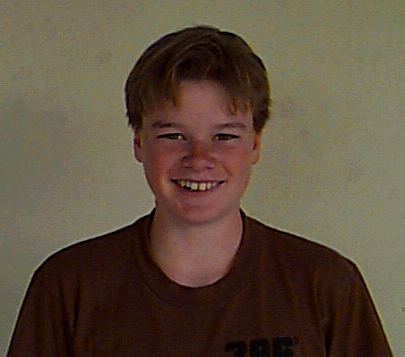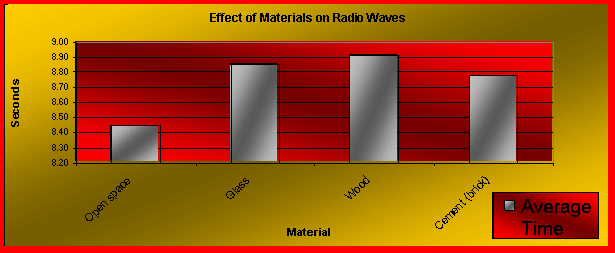How Do Different Obstacles Affect Radio Waves?
Ross .S
SOAR 6th 1998

PURPOSE
The purpose of this experiment was to find out which materials block radio waves and thus cause the most interference for remote control devices.
I became interested in this idea because I wanted to know what objects I have in my house that would cause interference to my R/C car.
The information gained from this experiment will help if someone is using remote control robotics or devices. It may be useful for scientific reasons, remote exploration as well as recreation. This experiment will benefit all those by determining which materials a R/C car user should avoid transmitting through.

HYPOTHESIS
My hypothesis is that the cement (brick) will give the least interference and that the glass will have the most interference.
I base my hypothesis on a book series called Elements; the AEE homepage and an encyclopedia called Science & Technology. I also base my hypothesis on my own educated guess that glass has very compressed molecules and a reflective surface, and brick has cracks and spaced out molecules.

EXPERIMENT DESIGN
The constants in this study were:
 The obstacle used to obstruct the radio wave
The obstacle used to obstruct the radio wave
 The distance for the radio wave to travel
The distance for the radio wave to travel
 The distance for the car (receiver) to travel
The distance for the car (receiver) to travel
 The amount of time it took the car to travel from the beginning court to half court
The amount of time it took the car to travel from the beginning court to half court
The manipulated variable was the amount of time it took the radio wave to pierce the obstacle (the wood, glass and brick). Then hit the receiver and cause the remote control car to move and then hit the centerline at half court.
The responding variable was the amount of time it took the car to start up from the beginning court line to then drive and arrive at the half court line.
To measure the responding variable I used a stopwatch to determine how much time it took the car to go from the beginning of the basketball court to the center of the basketball court.

MATERIALS
QUANTITY ITEM DESCRIPTION *C/A= Commonly Available
*C/A Cement (brick)
*C/A Wood
*C/A Glass
1 Stop-watch
1 27 MHz remote control car
24 AA alkaline batteries OR batteries
6 9v batteries OR
1 rechargeable 9v batteries

PROCEDURES
1. Place remote control car's (receiver) back wheals on the very edge of the beginning line of the basketball court.
2. Get someone (friend, family) to hold the remote control (transmitter) and stand outside the door of the gymnasium.
3. Have stopwatch set to proper setting.
4. Get to eye level with the mid-court centerline or where the car will stop.
5. Shout out a signal, like "GO!" then immediately start the stopwatch.
6. When the car touches the beginning on the mid-court line stop the stopwatch and give a signal to stop, like "STOP!"
7A. Place 4 new AA alkaline batteries in car OR
7B. Recharge 4 AA alkaline batteries from car then replace.
8A. Place 1 new 9v battery in remote control OR
8B. Recharge 1 9v battery then replace.
9. Close the door of gymnasium, with assistant remaining behind the door, to give you the material of glass.
10. Repeat steps 1 - 8B; be sure to replace step 2 with step 9.
11. Have assistant stand behind the boy's locker room wall to give the material of cement.
12. Repeat steps 1 - 8B; once again replace step 2 with step 11.
13. Have assistant stand outside the closed wooden door (separating the transmitter from the receiver) to give material of wood.
14. Repeat steps 1 - 8B; replace step 2 with step 13.
15. Repeat all steps (including steps 11 and 13) at least once more to confirm previous results.

RESEARCH REPORT
INTRODUCTION
My project is called, "How Do Different Obstacles Affect Radio Waves?". I learned about the different types of radio waves, and also learned about their many uses.
Types of Radio Waves
There is a large amount and Varity of radio waves, the two most radio waves would have to be AM and FM. AM (Amplitude Modulation) transmits by being transmitted into the air, it is bounced of the ionosphere and then reflected back to an antenna of a radio or other receiver. Unfortunately, this makes the radio wave more prone to interference like lightning or interference by other radio waves. FM (Frequency Modulation) is sent on a ground wave. This ground wave spreads out across the ground to reach radios. Sometimes when you drive in hilly areas, the FM wave is blocked out and the signal becomes mixed with static. The FM radio wave cannot be reflected off the ionosphere because the signal pierces through the earth's atmosphere and travels through space.
Uses of Radio Waves
The uses of radio waves are vast and extreme. One use, being the most obvious, is entertainment. The standard AM FM radio can cover 53-171 kHz with FM and 88-108 MHz is used by AM. A TV uses both AM and FM to broadcast their signals to televisions all over the world. One other popular use is recreation. Remote control models are a common hobby, whether you build them or just by ones to race others. Remote control models/toys are usually brodcasted on frequencies from 1-80 MHz. \par Another use is the exploration of space. A radio telescope uses FM signals to send out in space to record the distance of objects. When the signal hits something, it bounces back and is recorded on a computer. The radio wave can be used to explore the earth too. Small remotely controlled, unmanned submarines have been sent to the depths of the oceans with cameras to record things that would be extremely expensive find out. Remote controlled robots on land can be sent into volcanoes or other hostile environments to gather information. \par The largest and most important use is communication. Walkie-talkies are used by policemen, firemen, the army and some have even been made for a more kind of family use. A more recreational communication is HAM radio; HAM radio is a sort of amateur radio. Although many of the people who use it are far from amateur for they can reach people all across the globe.
The Basics of an R/C Car
The more common toy-type remote control car uses the same frequencies as other more model-type cars. The two frequencies made most available by the toy-type R/C's are 27 MHz and 49 MHz. The common toy-type R/C uses a simple kind of direct radio wave. When you press a button or move a lever on the transmitter, it sends a precise signal to one of the R/C car's many carefully tuned servos. The common car uses a rather simple motor that is battery powered. The model car is almost the same as the common one. With the exception that their motors are much more advance and can even be gasoline powered. Also, the advance car may have more controls, thus having more servos.
SUMMERY
The two main radio waves are AM and FM. Radio waves are used for communication, recreation, the exploration of space and the exploration of our earth. A remote control car usually will use a simple radio wave transmitted by the controls to function.

RESULTS
The original purpose of this experiment was to see which materials, out of wood cement and glass, conducted the most interference against radio waves. Hopefully the materials would cause the loss of speed in the car (receiver).
The results of the experiment were surprising. I was a little unhappy with how the accuracy of the experiment was. For example the car did not always go completely straight due to the crude way of having to align the car's wheels with the simple line on the basketball court. Another example would probable be the amount of hesitation that was present, even being off by about a hundredth or tenth of a second would have to be noted. I believe that the start of the stopwatch and the starting of the car were not started right on the mark.
See the table and graph below.



CONCLUSION
My hypothesis was incorrect. The wood offered the most interference, and then the glass and the brick offered the least interference to the radio waves. The results indicate that this hypothesis should be rejected. I thought that the glass would have the biggest results on the radio waves, but in actuality the wood offered more interference and the brick offered the least.
Because of the results of this experiment, I wonder if the way I chose to measure the material's interference on the radio waves was the best choice. If I were to conduct this project again I would definitely rethink the choice of car and choice of experiment on the radio waves.

A clear, plastic, rigid-walled tube
with at least a 1 inch (2.5 cm) inner diameter and at least 3 feet (90 cm) long. Available at your local plastic store. (Longer tubes show the effect more clearly.)
A solid rubber stopper and a one-hole rubber stopper to fit in the ends of the plastic tube.
A section of copper tubing about 4 inches (10 cm) long that fits tightly in the hole in the rubber stopper (glass tubing can be used if care is taken).
A thick-walled flexible plastic or rubber vacuum tubing about 6 feet (180 cm) long.
A coin and a feather (or a small piece of paper).
A vacuum pump (use a regular lab vacuum pump if available; if not, use a small hand pump such as Mityvac®).
2 hose clamps.
Adult help.
